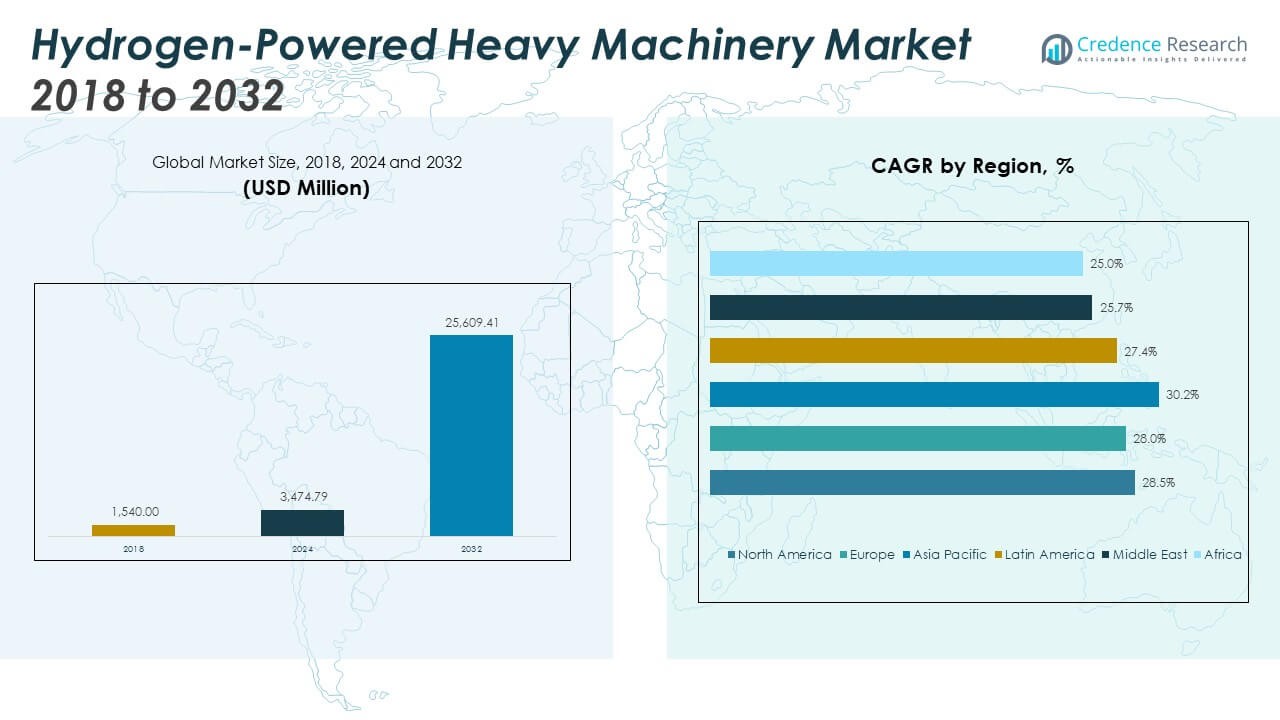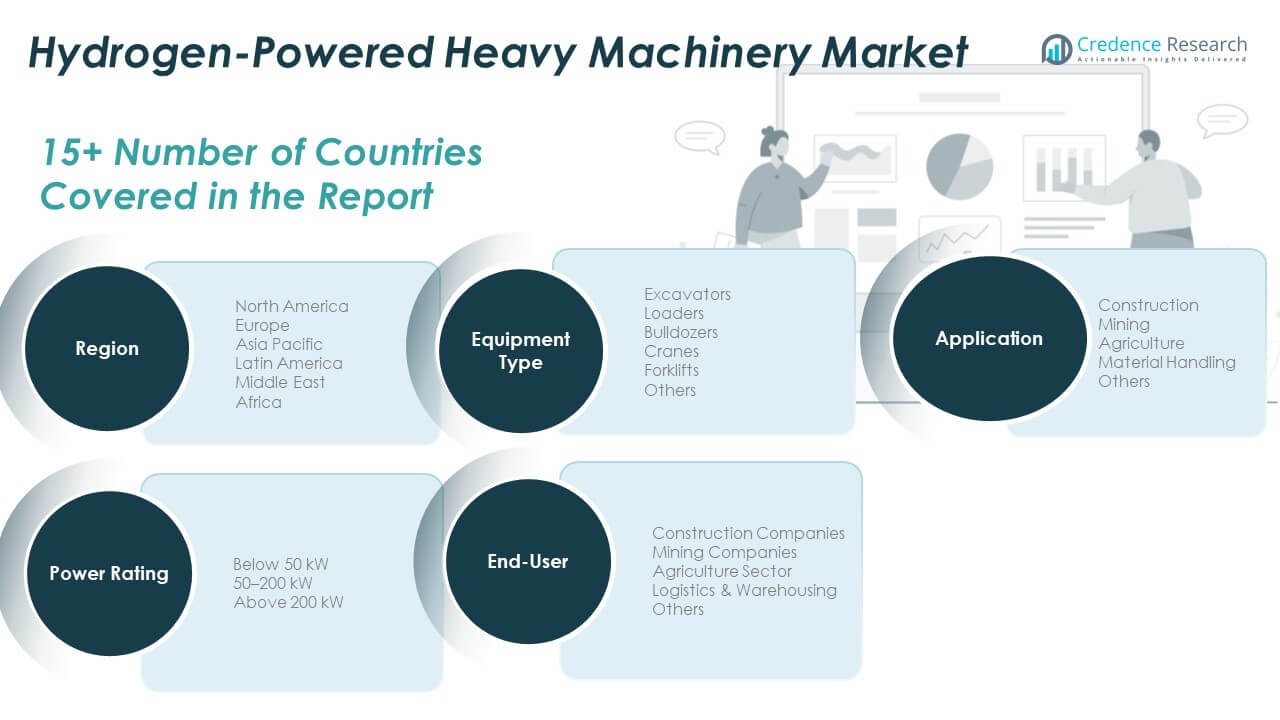CHAPTER NO. 1 : GENESIS OF THE MARKET
1.1 Market Prelude – Introduction & Scope
1.2 The Big Picture – Objectives & Vision
1.3 Strategic Edge – Unique Value Proposition
1.4 Stakeholder Compass – Key Beneficiaries
CHAPTER NO. 2 : EXECUTIVE LENS
2.1 Pulse of the Industry – Market Snapshot
2.2 Growth Arc – Revenue Projections (USD Million)
2.3. Premium Insights – Based on Primary Interviews
CHAPTER NO. 3 : HYDROGEN-POWERED HEAVY MACHINERY MARKET FORCES & INDUSTRY PULSE
3.1 Foundations of Change – Market Overview
3.2 Catalysts of Expansion – Key Market Drivers
3.2.1 Momentum Boosters – Growth Triggers
3.2.2 Innovation Fuel – Disruptive Technologies
3.3 Headwinds & Crosswinds – Market Restraints
3.3.1 Regulatory Tides – Compliance Challenges
3.3.2 Economic Frictions – Inflationary Pressures
3.4 Untapped Horizons – Growth Potential & Opportunities
3.5 Strategic Navigation – Industry Frameworks
3.5.1 Market Equilibrium – Porter’s Five Forces
3.5.2 Ecosystem Dynamics – Value Chain Analysis
3.5.3 Macro Forces – PESTEL Breakdown
3.6 Price Trend Analysis
3.6.1 Regional Price Trend
3.6.2 Price Trend by product
CHAPTER NO. 4 : KEY INVESTMENT EPICENTER
4.1 Regional Goldmines – High-Growth Geographies
4.2 Product Frontiers – Lucrative Product Categories
4.3 Application Sweet Spots – Emerging Demand Segments
CHAPTER NO. 5: REVENUE TRAJECTORY & WEALTH MAPPING
5.1 Momentum Metrics – Forecast & Growth Curves
5.2 Regional Revenue Footprint – Market Share Insights
5.3 Segmental Wealth Flow – Equipment Type & Application Revenue
CHAPTER NO. 6 : TRADE & COMMERCE ANALYSIS
6.1. Import Analysis by Region
6.1.1. Global Hydrogen-Powered Heavy Machinery Market Import Revenue By Region
6.2. Export Analysis by Region
6.2.1. Global Hydrogen-Powered Heavy Machinery Market Export Revenue By Region
CHAPTER NO. 7 : COMPETITION ANALYSIS
7.1. Company Market Share Analysis
7.1.1. Global Hydrogen-Powered Heavy Machinery Market: Company Market Share
7.2. Global Hydrogen-Powered Heavy Machinery Market Company Revenue Market Share
7.3. Strategic Developments
7.3.1. Acquisitions & Mergers
7.3.2. New Product Launch
7.3.3. Regional Expansion
7.4. Competitive Dashboard
7.5. Company Assessment Metrics, 2024
CHAPTER NO. 8 : HYDROGEN-POWERED HEAVY MACHINERY MARKET – BY EQUIPMENT TYPE SEGMENT ANALYSIS
8.1. Hydrogen-Powered Heavy Machinery Market Overview by Equipment Type Segment
8.1.1. Hydrogen-Powered Heavy Machinery Market Revenue Share By Equipment Type
8.2. Excavators
8.3. Loaders
8.4. Bulldozers
8.5. Cranes
8.6. Forklifts
8.7. Others
CHAPTER NO. 9 : HYDROGEN-POWERED HEAVY MACHINERY MARKET – BY APPLICATION SEGMENT ANALYSIS
9.1. Hydrogen-Powered Heavy Machinery Market Overview by Application Segment
9.1.1. Hydrogen-Powered Heavy Machinery Market Revenue Share By Application
9.2. Construction
9.3. Mining
9.4. Agriculture
9.5. Material Handling
9.6. Others
CHAPTER NO. 10 : HYDROGEN-POWERED HEAVY MACHINERY MARKET – BY END-USER SEGMENT ANALYSIS
10.1. Hydrogen-Powered Heavy Machinery Market Overview by End-user Segment
10.1.1. Hydrogen-Powered Heavy Machinery Market Revenue Share By End-user
10.2. Construction Companies
10.3. Mining Companies
10.4. Agriculture Sector
10.5. Logistics & Warehousing
10.6. Others
CHAPTER NO. 11 : HYDROGEN-POWERED HEAVY MACHINERY MARKET – BY POWER RATING SEGMENT ANALYSIS
11.1. Hydrogen-Powered Heavy Machinery Market Overview by Power Rating Segment
11.1.1. Hydrogen-Powered Heavy Machinery Market Revenue Share By Power Rating
11.2. Below 50 kW
11.3. 50–200 kW
11.4. Above 200 kW
CHAPTER NO. 12 : HYDROGEN-POWERED HEAVY MACHINERY MARKET – REGIONAL ANALYSIS
12.1. Hydrogen-Powered Heavy Machinery Market Overview by Region Segment
12.1.1. Global Hydrogen-Powered Heavy Machinery Market Revenue Share By Region
12.1.2. Regions
12.1.3. Global Hydrogen-Powered Heavy Machinery Market Revenue By Region
12.1.4. Equipment Type
12.1.5. Global Hydrogen-Powered Heavy Machinery Market Revenue By Equipment Type
12.1.6. Application
12.1.7. Global Hydrogen-Powered Heavy Machinery Market Revenue By Application
12.1.8. End-user
12.1.9. Global Hydrogen-Powered Heavy Machinery Market Revenue By End-user
12.1.10. Power Rating
12.1.11. Global Hydrogen-Powered Heavy Machinery Market Revenue By Power Rating
CHAPTER NO. 13 : NORTH AMERICA HYDROGEN-POWERED HEAVY MACHINERY MARKET – COUNTRY ANALYSIS
13.1. North America Hydrogen-Powered Heavy Machinery Market Overview by Country Segment
13.1.1. North America Hydrogen-Powered Heavy Machinery Market Revenue Share By Region
13.2. North America
13.2.1. North America Hydrogen-Powered Heavy Machinery Market Revenue By Country
13.2.2. Equipment Type
13.2.3. North America Hydrogen-Powered Heavy Machinery Market Revenue By Equipment Type
13.2.4. Application
13.2.5. North America Hydrogen-Powered Heavy Machinery Market Revenue By Application
13.2.6. End-user
13.2.7. North America Hydrogen-Powered Heavy Machinery Market Revenue By End-user
13.2.8. Power Rating
13.2.9. North America Hydrogen-Powered Heavy Machinery Market Revenue By Power Rating
13.3. U.S.
13.4. Canada
13.5. Mexico
CHAPTER NO. 14 : EUROPE HYDROGEN-POWERED HEAVY MACHINERY MARKET – COUNTRY ANALYSIS
14.1. Europe Hydrogen-Powered Heavy Machinery Market Overview by Country Segment
14.1.1. Europe Hydrogen-Powered Heavy Machinery Market Revenue Share By Region
14.2. Europe
14.2.1. Europe Hydrogen-Powered Heavy Machinery Market Revenue By Country
14.2.2. Equipment Type
14.2.3. Europe Hydrogen-Powered Heavy Machinery Market Revenue By Equipment Type
14.2.4. Application
14.2.5. Europe Hydrogen-Powered Heavy Machinery Market Revenue By Application
14.2.6. End-user
14.2.7. Europe Hydrogen-Powered Heavy Machinery Market Revenue By End-user
14.2.8. Power Rating
14.2.9. Europe Hydrogen-Powered Heavy Machinery Market Revenue By Power Rating
14.3. UK
14.4. France
14.5. Germany
14.6. Italy
14.7. Spain
14.8. Russia
14.9. Rest of Europe
CHAPTER NO. 15 : ASIA PACIFIC HYDROGEN-POWERED HEAVY MACHINERY MARKET – COUNTRY ANALYSIS
15.1. Asia Pacific Hydrogen-Powered Heavy Machinery Market Overview by Country Segment
15.1.1. Asia Pacific Hydrogen-Powered Heavy Machinery Market Revenue Share By Region
15.2. Asia Pacific
15.2.1. Asia Pacific Hydrogen-Powered Heavy Machinery Market Revenue By Country
15.2.2. Equipment Type
15.2.3. Asia Pacific Hydrogen-Powered Heavy Machinery Market Revenue By Equipment Type
15.2.4. Application
15.2.5. Asia Pacific Hydrogen-Powered Heavy Machinery Market Revenue By Application
15.2.6. End-user
15.2.7. Asia Pacific Hydrogen-Powered Heavy Machinery Market Revenue By End-user
15.2.8. Power Rating
15.2.9. Asia Pacific Hydrogen-Powered Heavy Machinery Market Revenue By Power Rating
15.3. China
15.4. Japan
15.5. South Korea
15.6. India
15.7. Australia
15.8. Southeast Asia
15.9. Rest of Asia Pacific
CHAPTER NO. 16 : LATIN AMERICA HYDROGEN-POWERED HEAVY MACHINERY MARKET – COUNTRY ANALYSIS
16.1. Latin America Hydrogen-Powered Heavy Machinery Market Overview by Country Segment
16.1.1. Latin America Hydrogen-Powered Heavy Machinery Market Revenue Share By Region
16.2. Latin America
16.2.1. Latin America Hydrogen-Powered Heavy Machinery Market Revenue By Country
16.2.2. Equipment Type
16.2.3. Latin America Hydrogen-Powered Heavy Machinery Market Revenue By Equipment Type
16.2.4. Application
16.2.5. Latin America Hydrogen-Powered Heavy Machinery Market Revenue By Application
16.2.6. End-user
16.2.7. Latin America Hydrogen-Powered Heavy Machinery Market Revenue By End-user
16.2.8. Power Rating
16.2.9. Latin America Hydrogen-Powered Heavy Machinery Market Revenue By Power Rating
16.3. Brazil
16.4. Argentina
16.5. Rest of Latin America
CHAPTER NO. 17 : MIDDLE EAST HYDROGEN-POWERED HEAVY MACHINERY MARKET – COUNTRY ANALYSIS
17.1. Middle East Hydrogen-Powered Heavy Machinery Market Overview by Country Segment
17.1.1. Middle East Hydrogen-Powered Heavy Machinery Market Revenue Share By Region
17.2. Middle East
17.2.1. Middle East Hydrogen-Powered Heavy Machinery Market Revenue By Country
17.2.2. Equipment Type
17.2.3. Middle East Hydrogen-Powered Heavy Machinery Market Revenue By Equipment Type
17.2.4. Application
17.2.5. Middle East Hydrogen-Powered Heavy Machinery Market Revenue By Application
17.2.6. End-user
17.2.7. Middle East Hydrogen-Powered Heavy Machinery Market Revenue By End-user
17.2.8. Power Rating
17.2.9. Middle East Hydrogen-Powered Heavy Machinery Market Revenue By Power Rating
17.3. GCC Countries
17.4. Israel
17.5. Turkey
17.6. Rest of Middle East
CHAPTER NO. 18 : AFRICA HYDROGEN-POWERED HEAVY MACHINERY MARKET – COUNTRY ANALYSIS
18.1. Africa Hydrogen-Powered Heavy Machinery Market Overview by Country Segment
18.1.1. Africa Hydrogen-Powered Heavy Machinery Market Revenue Share By Region
18.2. Africa
18.2.1. Africa Hydrogen-Powered Heavy Machinery Market Revenue By Country
18.2.2. Equipment Type
18.2.3. Africa Hydrogen-Powered Heavy Machinery Market Revenue By Equipment Type
18.2.4. Application
18.2.5. Africa Hydrogen-Powered Heavy Machinery Market Revenue By Application
18.2.6. End-user
18.2.7. Africa Hydrogen-Powered Heavy Machinery Market Revenue By End-user
18.2.8. Power Rating
18.2.9. Africa Hydrogen-Powered Heavy Machinery Market Revenue By Power Rating
18.3. South Africa
18.4. Egypt
18.5. Rest of Africa
CHAPTER NO. 19 : COMPANY PROFILES
19.1. Ballard Power Systems
19.1.1. Company Overview
19.1.2. Product Portfolio
19.1.3. Financial Overview
19.1.4. Recent Developments
19.1.5. Growth Strategy
19.1.6. SWOT Analysis
19.2. Cummins Inc.
19.3 Plug Power Inc.
19.4. Nikola Corporation
19.5. Toyota Motor Corporation
19.6. Hyundai Motor Company
19.7. JCB (J.C. Bamford Excavators Limited)
19.8. Caterpillar Inc.
19.9. Komatsu Ltd.
19.10. Doosan Mobility Innovation
19.11. Liebherr Group
19.12. Hyzon Motors
19.13. SANY Group
19.14. Bosch Rexroth AG
19.15. Siemens AG
19.16. Hyster-Yale Group
19.17. Alstom SA
19.18. Anglo American plc
19.19. Mitsubishi Heavy Industries, Ltd.










